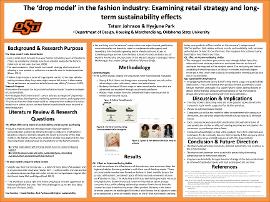| dc.contributor.advisor | Park, Hyejune | |
| dc.contributor.author | Johnson, Tatum | |
| dc.date.accessioned | 2022-04-21T18:37:26Z | |
| dc.date.available | 2022-04-21T18:37:26Z | |
| dc.date.issued | 2022-04-15 | |
| dc.identifier | oksd_Wentz_2022_johnson | |
| dc.identifier.citation | Johnson, T., & Park, H. (2022, April 15). The 'drop' model in the fashion industry: Examining retail strategy and long-term sustainability effects. Poster session presented at the Oklahoma State University Wentz Research Scholars Symposium, Stillwater, OK. | |
| dc.identifier.uri | https://hdl.handle.net/11244/335274 | |
| dc.description.abstract | From a retail giant, Amazon, to luxury fashion brands like Gucci and Burberry, 'drops' as a marketing strategy have been adopted widely by the fashion industry in recent years (Larsson, 2020). The new innovation, the 'drop' model is a brand's strategy that consists of releasing a new product or collection at a specific time in limited quantities (Elven, 2018). Product drops impose a sense of urgency and scarcity to increase sales by making customers buy the product right away at full prices. It also creates 'brand excitement as a method to build consumer affinity' (Larsson, 2020). The purpose of this study was to examine the impact of the drop model on fashion brands' business strategies and sustainability. Three research objectives were established: (a) to investigate the fashion brands' current business strategies for the 'drop model' including product development, marketing communications, and supply chain,(b) to examine whether the drop model has any positive implications for sustainability, and (c) to evaluate how the drop model could be compared with traditional business models such as fast fashion and how fashion brands should move forward in the coming years. To achieve the research objectives, content analysis, and a case study approach were adopted. I examined selected cases that were useful in supplying insight into a topic of interest and in leading to a better understanding of a research phenomenon. Based on the result of the content analysis, I selected three sample brands that have adopted the drop model. Within the case study, each sample brand's drop model strategies in terms of product development, marketing communications, and supply chain were be analyzed using content analysis and other unobtrusive observation measures. The sample brands' websites and social media sites were also investigated. Conclusions from my research revealed the 'drop model' promotes more sustainable practices by eliminating overproduction in the fashion industry. The drop model generates exclusivity, demand, excitement, and incentive in the product market. Long-term sustainability through the retail strategy of the drop model could be achieved if applied properly with high-quality products and lines. | |
| dc.description.sponsorship | Lew Wentz Foundation | |
| dc.format | application/pdf | |
| dc.language | en_US | |
| dc.publisher | Oklahoma State University | |
| dc.rights | In the Oklahoma State University Library's institutional repository this paper is made available through the open access principles and the terms of agreement/consent between the author(s) and the publisher. The permission policy on the use, reproduction or distribution of the article falls under fair use for educational, scholarship, and research purposes. Contact Digital Resources and Discovery Services at lib-dls@okstate.edu or 405-744-9161 for further information. | |
| dc.title | 'Drop' model in the fashion industry: Examining retail strategy and long-term sustainability effects | |
| osu.filename | oksd_Wentz_2022_johnson.pdf | |
| dc.description.department | Design, Housing and Merchandising | |
| dc.type.genre | Poster | |
| dc.type.material | Text | |
| dc.type.material | Image | |
